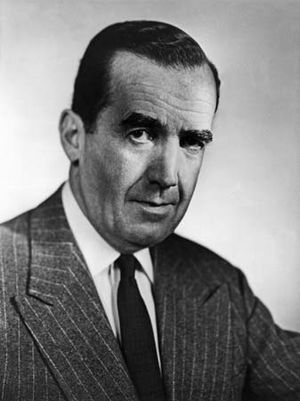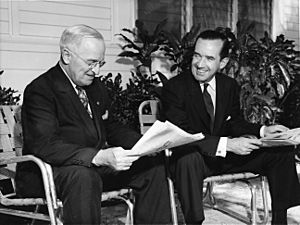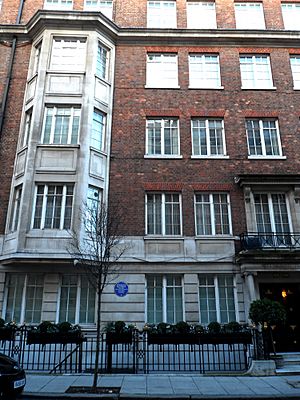Edward R. Murrow facts for kids
Quick facts for kids
Edward R. Murrow
|
|
|---|---|

Murrow in 1961
|
|
| Born |
Egbert Roscoe Murrow
April 25, 1908 |
| Died | April 27, 1965 (aged 57) Pawling, New York, U.S.
|
| Resting place | Glen Arden Farm |
| Alma mater | Washington State University |
| Occupation |
|
| Years active | 1935–1965 |
| Known for |
|
| Spouse(s) |
Janet Huntington Brewster
(m. 1935) |
| Children | 1 |
| Signature | |
Edward Roscoe Murrow (born Egbert Roscoe Murrow; April 25, 1908 – April 27, 1965) was a famous American journalist. He was known for his powerful radio and television reports. Murrow became well-known during World War II for his live radio broadcasts from Europe for CBS News. He worked with a team of reporters called the "Murrow Boys."
Murrow was a pioneer in news broadcasting. He created TV reports on his show See It Now. These reports helped lead to the official disapproval of U.S. Senator Joseph McCarthy. Many journalists consider Murrow one of the greatest figures in journalism history.
Contents
Early Life and Education
Murrow was born Egbert Roscoe Murrow in North Carolina. His parents were Quakers, a Christian group known for peace. He was the youngest of four brothers. His family lived in a simple log cabin without electricity or running water.
When Murrow was six, his family moved to Washington state. He went to high school in Edison. He was president of his senior class and was great at debate. He also played on the basketball team.
After high school in 1926, Murrow went to Washington State College. He studied speech there. During college, he changed his name from Egbert to Edward. In 1929, he became president of the National Student Federation of America. He encouraged students to care more about national and world events. After college in 1930, he moved to New York.
From 1932 to 1935, Murrow worked for the Institute of International Education. He helped German scholars who had lost their jobs. He married Janet Huntington Brewster in 1935. Their son, Charles Casey Murrow, was born in London in 1945.
Career at CBS
Murrow joined CBS in 1935. He was the director of talks and education. At that time, CBS did not have a news staff. Murrow's job was to find important people to speak on the radio. He learned a lot about broadcasting from announcer Bob Trout.
In 1937, Murrow moved to London. He became the director of CBS's European operations. His job was to get European figures to broadcast on CBS. He traveled often around Europe. In 1937, he hired journalist William L. Shirer. This was the start of the "Murrow Boys" team of war reporters.
Radio Reporting During World War II
Murrow became famous during the Anschluss in March 1938. This was when Adolf Hitler took over Austria. Murrow was in Poland when he heard the news. He quickly sent Shirer to London to report. Then, Murrow flew to Vienna to report live himself.
Murrow and Shirer created a European News Roundup. This special broadcast brought reporters from different European cities together. It was broadcast on March 13, 1938. Murrow reported live from Vienna. This was his first on-the-scene news report. This broadcast was revolutionary because it was live and from multiple locations. It became the basis for World News Roundup, which is still on the air today.
In September 1938, Murrow and Shirer reported on the crisis in Czechoslovakia. Listeners eagerly awaited Murrow's shortwave broadcasts. These often began with "Calling Ed Murrow... come in Ed Murrow."
When World War II started in September 1939, Murrow stayed in London. He gave live radio reports during the Blitz, when Germany bombed London. These broadcasts, called London After Dark, thrilled radio audiences. Before this, war news mostly came from newspapers or newsreels.
World War II Reporting
Murrow's reports from the Blitz became very famous. He started his broadcasts with his signature opening: "This is London." This phrase became strongly linked with him and CBS.
He also became known for his closing phrase: "Good night, and good luck." Londoners often said this to each other during the bombings. Murrow started using it at the end of his broadcasts in 1940.
When Murrow returned to the U.S. in 1941, CBS held a big dinner for him. President Franklin D. Roosevelt sent a welcome message. Librarian of Congress Archibald MacLeish praised Murrow's reporting. He said Murrow made Americans feel the war's impact directly.
After the Japanese attack on Pearl Harbor, the U.S. entered the war. Murrow flew on 25 Allied combat missions in Europe. He reported from the planes during these missions. His ability to describe events vividly made his broadcasts very effective.
Murrow built the CBS News team in London into a top news staff. This group of reporters became known as "Murrow's Boys." They included talented journalists like Eric Sevareid and Charles Collingwood. Even though the name was "Boys," Mary Marvin Breckinridge was also part of the team.
On April 12, 1945, Murrow and Bill Shadel were among the first reporters at the Buchenwald concentration camp in Germany. Murrow reported on the terrible conditions he saw there. He described the emaciated survivors and the bodies. His report helped show the world the horrors of the Holocaust.
Postwar Broadcasting Career

In 1945, Murrow became a vice president and head of CBS News. He made his last news report from London in March 1946. He shaped the newsroom with his strong personality. He remained close friends with the "Murrow Boys."
Murrow returned to reporting in September 1947. He took over a nightly newscast. For several years, he focused on radio news. He also produced special radio programs. From 1951 to 1955, Murrow hosted This I Believe. This show allowed ordinary people to share their beliefs. He continued daily radio news reports until 1959.
He also created historical audio albums called I Can Hear It Now. These led to a weekly CBS Radio show, Hear It Now, which he co-produced with Fred W. Friendly.
Television and Films
In the 1950s, Murrow started working in television. He had some doubts about TV, thinking it focused too much on looks. But on November 18, 1951, Hear It Now moved to TV and became See It Now. Murrow explained, "This is an old team, trying to learn a new trade."
In 1953, Murrow started another TV show called Person to Person. This show featured interviews with celebrities.
Criticism of McCarthyism
See It Now covered many important issues. It is most famous for criticizing McCarthyism. This was a time when Senator Joseph McCarthy accused many people of being communists without strong evidence.
On March 9, 1954, Murrow and his team produced a special See It Now report. It was called "A Report on Senator Joseph McCarthy." Murrow used clips from McCarthy's own speeches. He showed how McCarthy contradicted himself. Murrow and his producer, Fred Friendly, even paid for their own newspaper ad for the show.
This broadcast greatly contributed to a national reaction against McCarthy. It is seen as a turning point in television history. CBS received many calls and letters supporting Murrow. Truck drivers would even shout "Good show, Ed!" to him on the street.
Murrow offered McCarthy a chance to respond on See It Now. McCarthy appeared on April 6, 1954. He criticized Murrow and accused him of being a communist supporter. However, McCarthy's response only made him less popular. Murrow later pointed out that McCarthy had not addressed any of the facts presented in the original report.
Later Television Career
Murrow's direct approach to news sometimes caused problems with CBS. See It Now had good ratings when it covered big topics. But generally, it wasn't a prime-time hit.
In 1955, See It Now lost its weekly slot. It continued as a series of special news reports. But CBS found it hard to find a regular sponsor for the show.
In 1958, Murrow hosted Small World, a talk show with political figures. See It Now ended completely in the summer of 1958. Murrow had disagreements with CBS chairman William Paley. Murrow felt he couldn't continue if the network kept giving equal time to people who felt criticized by the show.
Murrow's relationship with Paley became strained. Also, new journalists like Walter Cronkite were rising at CBS. This created some professional rivalry.
After See It Now ended, Murrow was asked to run for the Senate in New York. But he decided to remain a journalist.
Murrow's last major TV report was Harvest of Shame in November 1960. This report showed the difficult lives of migrant farmworkers in the United States.
Summary of Television Work
- 1951–1958 – See It Now (host)
- 1953–1959 – Person to Person (host)
- 1958–1960 – Small World (moderator and producer)
United States Information Agency (USIA) Director
In January 1961, Murrow left CBS. President John F. Kennedy asked him to lead the United States Information Agency (USIA). This agency shared the U.S. government's views with people in other countries. Murrow's fame helped the agency get more funding.
Murrow insisted on having direct access to President Kennedy. He said, "If you want me in on the landings, I'd better be there for the takeoffs." Due to early signs of cancer, he couldn't be very active in the Bay of Pigs Invasion planning. He did advise the president during the Cuban Missile Crisis.
Murrow resigned in early 1964 due to his illness.
Death
Murrow was a heavy smoker throughout his life. He was rarely seen without a cigarette. It was reported that he smoked around three packs a day. See It Now was the first TV show to report on the link between smoking and cancer. Murrow himself said he found it hard to go a half hour without a cigarette. He developed lung cancer.
Edward R. Murrow died at his home in Pawling, New York, on April 27, 1965. He passed away two days after his 57th birthday. His friend Eric Sevareid said Murrow was "a shooting star." CBS aired a memorial program for him.
Honors and Legacy
Murrow received many awards for his journalism. He won the Peabody Award multiple times. In 1964, he received the Presidential Medal of Freedom, a very high honor in the U.S. He was also made an honorary Knight Commander by Queen Elizabeth II of Britain.
The Edward R. Murrow Award is given annually for great achievements in electronic journalism. His alma mater, Washington State University, named its communication college the Edward R. Murrow College of Communication in his honor. There are also parks and a high school named after him.

After Murrow's death, the Edward R. Murrow Center of Public Diplomacy was created at Tufts University. His papers and belongings are kept there for research.
Several movies have been made about Murrow. The 1986 film Murrow starred Daniel J. Travanti as Murrow. The 2005 Oscar-nominated film Good Night, and Good Luck was directed by George Clooney. It showed the conflict between Murrow and Senator Joseph McCarthy. David Strathairn played Murrow in this film.
Works
Filmography
- Around the World in 80 Days (1956) as Prologue Narrator
- Sink the Bismarck! (1960) as himself (final film role)
- Murrow (1986) biographical movie
- Good Night, and Good Luck (2005) historical drama about Murrow and Joseph McCarthy
See also
 In Spanish: Edward R. Murrow para niños
In Spanish: Edward R. Murrow para niños



